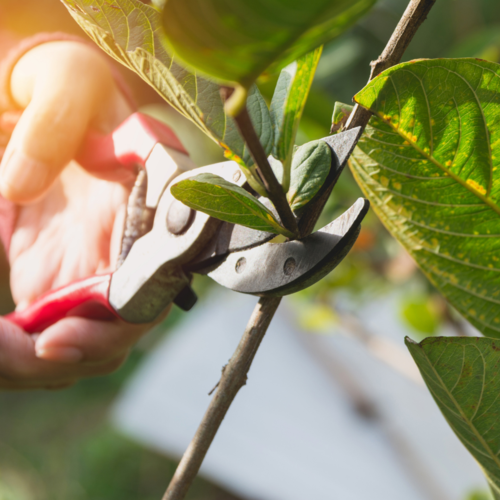Pruning might be the best trick there is to helping your plants grow to their fullest potential. By removing dead or dying branches, you’re removing the risk of disease to the entire plant. With the proper tool, you can expect your plant to recover faster from clippings. A clean pruning cut will remove the risk of unwanted mites and insects from entering your plant, causing further damage.
Pruning Tools
To start, let’s make sure you have the right tools for the job. Choosing the right tool for your pruning task is important. Using the right tool will allow you to create the perfect cuts safely for you and your plants. Here are the top 5 must have pruning tools for all your pruning needs.
1. Pruners

The number one pruning tool for all gardeners to have is a good pair of pruners. The sharp curved blade creates a clean-cut, allowing plants to heal faster. Great for small clippings like branches, flower stems and shrubs.
Pro-tip: When shopping for your pruners, look for a light pair with grip, this will allow you to work easily and more efficiently with one hand and will also prevent hand cramping.
2. Loppers

Loppers are the next level up from pruners. Used to cut through thicker branches, up to 2 inches thick. Use loppers to remove branch stubs and branches that rub together, inviting more light to access your plants. Great for fruit trees, nut trees and vines.
Pro-tip: Look for loppers that offer more power and grip. Using a lopper can require lots of force or very little depending on the enhanced power it provides. It is also important to test the weight of the product beforehand, to ensure that you’re capable of working with it safely.
3. Pole Pruners

Also known as ‘tree shears’. Pole pruners are the perfect tool to use for reaching dead branches. With a reach of up to 8 ft long, the pole pruner removes the unsafe need for using ladders. Great for cutting through branches up to 1 ¼ inch thick.
Pro-tip: For an easier way to prune tall and hard to reach branches, try using an electric pole pruner.
4. Hedge Shears

Great for small shrubs, hedges, evergreens, and perennials. Also known as ‘manual hedge trimmers’. Hedge Shears do the perfect job for shaping and trimming hedges, all while promoting new growth. Capable of cutting up to 2 ¼ inch thick branches and shrubs.
Pro-tip: Hedge Shears come in a variety of different blade types. Straight blades, wavy blades, and serrated blades all perform differently, so be sure to choose the right blade for the job.
5. Pruning Saw

For wood up to 5 inches thick. Pruning saws are the last manual pruning tool used to take care of a pruning tasks before upgrading to power tools. With sharp teeth, the pruning saw only requires a quick push and pull to make a clean cut through branches.
Pro-tip: Be sure to wear gloves with a good grip when handling a pruning saw. You want to maintain a tight grip with every push and pull to ensure full control when handling this tool. Safety first!
Clean Tools, Healthy Plants
Always, always, always keep your garden tools clean! Pruning with dirty tools doesn’t only make working with the tools much harder when they’re covered in sap and saw dust but it’s actually unhealthy for your plants. By not cleaning your tools you can transfer disease from branch to branch and even from plant to plant defeating the entire purpose of pruning. To prevent the spread of disease, clean your tools in-between each use and before storing. When cleaning your pruning tools be careful not to rust them. To do this you’ll want to spray your tools with rubbing alcohol, allow the alcohol to disinfect your tool for 20 seconds then wiping it off with a clean rag. This will not only kill bacteria but also clean stubborn sap.
Pro-tip: Keep a rag and 91% alcohol in your back pocket for quick access in between clippings.
When to Prune
For more pruning tips, check out the latest episode of ‘Get Up and Grow: When You Should Prune Your Plants, The Three D’s of Pruning’. Where our president Gord teaches Jasmine how to take care of her plants by showing her when to prune them and how.
Have a question? Let us know at info@wildwoodoutdoorliving.com.
Sign up here for more blogs dedicated to better gardening


